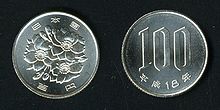Hi there Sakura tree lovers!
this is a begginer guide and a tirth post!
enjoy reading it
here are over one hundred cherry tree varieties in Japan. A few of them are wild varieties native to Japan's forests, such as the Yamazakura, but the large majority of them have been cultivated by humans over the centuries for decorative use in gardens and parks. By far the most popular cherry tree variety today is the particularly pretty, cultivated Somei Yoshino.
There are several characteristics differentiating the many cherry tree varieties. Some of the obvious ones, that can also be easily recognized by beginners, are listed below:
Number of petals
Most wild trees, but also a lot of cultivated tree varieties, have blossoms with five petals. However, some species have blossoms which consist of ten, twenty or more petals. Trees with blossoms of more than five petals are called yaezakura.
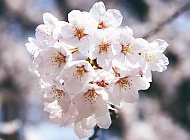
5 petals
(e.g. Somei Yoshino)
|
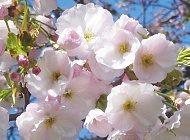
about 20 petals
(e.g. Ichiyo)
|
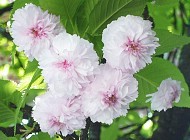
about 100 petals
(e.g. Kikuzakura)
|
Color of the blossoms
Most varieties produce light pink to white blossoms, but there are also cherry trees with dark pink, yellow or green blossoms. Furthermore, the color of some varieties' cherry blossoms may change while they are in bloom. For example, a blossom may open as a white flower and change color to pink over the course of a few days.
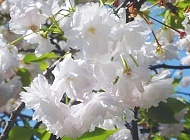
white blossoms
(e.g. Shogetsu)
|
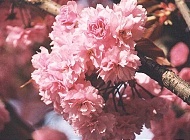
pink blossoms
(e.g. Kanzan)
|
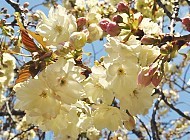
yellow blossoms
(e.g. Ukon)
|
The fresh leaves
In case of early blooming trees, the fresh leaves usually do not appear until after full bloom, which gives the trees an attractive, homogeneous look while they are in full bloom. In case of later blooming trees, the leaves usually appear before the blossoms, giving the trees a more heterogeneous look. Furthermore, the color of the fresh leaves differs between the varieties. In most cases, the fresh leaves are green, coppery brown, or something in between.
Time of blooming
Most cherry tree varieties carry blossoms in spring. Yaezakura, i.e. cherry trees with blossoms of more than five petals, are typically the last ones to open their blossoms, with blooming periods about two to four weeks after most five-petaled species. Some extreme varieties bloom in late autumn and during the winter months. Read more about when cherry trees are in bloom.
Form of the tree
Cherry trees display various growing habits and come in different shapes and forms: triangular, columnar, V-shape, weeping, flat-topped, etc. Weeping cherry trees are called shidarezakura.
Most common cherry tree varieties
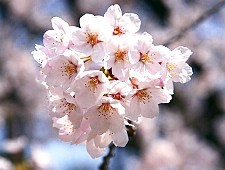 |
| Somei Yoshino (Yoshino Cherry) |
| Average blooming period in Tokyo: early April |
| Cultivated during the Edo Period in Tokyo, the Somei Yoshino is by far the most numerous cherry tree in Japan. Somei Yoshino trees come with slightly pink, almost white, 5-petaled blossoms. Their appearance is particularly intense thanks in part to the fact that their fresh leaves do not emerge until after the peak of the flowering season. |
|
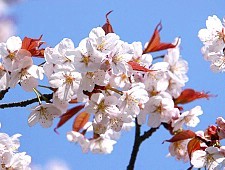 |
| Yamazakura |
| Average blooming period in Tokyo: early April |
| The yamazakura is the most common cherry tree variety of Japan that actually grows wildly in nature as opposed to cultivars such as the Somei Yoshino. Its blossoms are slightly pink and have five, relatively small petals. The Yamazakura's fresh leaves develop at the same time as the blossoms, giving the tree a somewhat less intense look than the Somei Yoshino. |
|
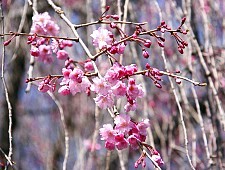 |
| Shidarezakura (Weeping Cherry) |
| Average blooming period in Tokyo: early April |
| Weeping cherry trees have drooping branches and are among the most common and beloved cherry trees in Japan. There are two types: trees with blossoms of five petals and trees with blossoms of more than five petals. The latter are called Yaeshidarezakura and bloom about a week later than the 5-petaled ones. |
|
Some early flowering cherry tree varieties
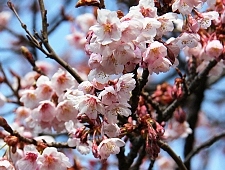 |
| Kanzakura |
| Average blooming period in Tokyo: late February to mid March |
| The Kanzakura is among the first cherry trees to bloom. It is encountered only in relatively small numbers in some city parks where they surprise and delight visitors with their early blooming schedule. |
|
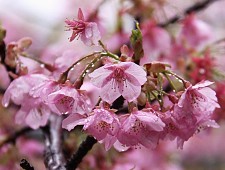 |
| Kawazuzakura |
| Average blooming period in Tokyo: mid March |
| Named after Kawazu Town on the Izu Peninsula, where the tree variety was originally cultivated, the Kawazuzakura is among the earliest flowering cherry trees. Large numbers of them bloom during the cherry blossom festival in Kawazu which is held annually in late February and early March. The tree is less common in other parts of Japan. |
|
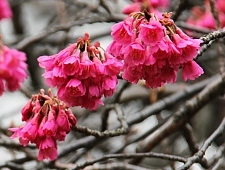 |
| Kanhizakura |
| Average blooming period in Tokyo: mid to late March |
| This tree with its dark pink, bell shaped flowers is native to Taiwan andOkinawa where it blooms as early as January and February. In the parks of Tokyo it is not usually in bloom until mid March, but still among the earliest blooming varieties. |
|
Some late flowering cherry tree varieties
 |
| Ichiyo |
| Average blooming period in Tokyo: mid April |
| The Ichiyo has about twenty, light pink petals per blossom, and its fresh leaves are green. It is among the most common, late flowering cherry varieties encountered in Japan's parks and gardens. |
|
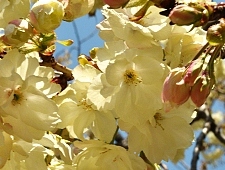 |
| Ukon |
| Average blooming period in Tokyo: mid April |
| The Ukon has about 10-20 petals per blossom and coppery leaves. Ukon trees are easily recognized by their blossoms' characteristic, yellowish color. |
|
 |
| Kanzan |
| Average blooming period in Tokyo: mid to late April |
| Among the many yaezakura varieties, the Kanzan is one of the most common. One Kanzan blossom consists of as many as 30-50 pink petals. The fresh leaves are coppery brown. |
|
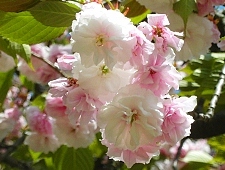 |
| Fugenzo |
| Average blooming period in Tokyo: mid to late April |
| The Fugenzo is a late blooming yaezakura with about 30-40 petals per blossom. White to slightly pink when they open, the blossoms turn into a darker pink over time. The fresh leaves are coppery brown. |
|
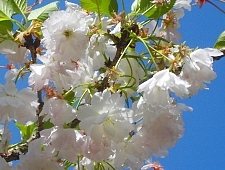 |
| Shogetsu |
| Average blooming period in Tokyo: mid to late April |
| The Shogetsu is a late blooming yaezakura with relatively large, white blossoms of about 20-30 petals. The fresh leaves are green. |
|
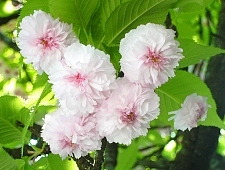 |
| Kikuzakura (Chrysanthemum Cherry) |
| Average blooming period in Tokyo: late April, early May |
| The Kikuzakura has as many as one hundred petals per blossom! It is also one of the latest blooming trees. In fact, by the time the blossoms are in bloom, the fresh leaves have already developed almost completely and are somewhat hiding the blossoms. |
|
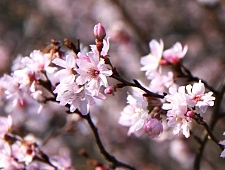 |
| Jugatsuzakura (Autumn Cherry) |
| Average blooming period in Tokyo: October to January and spring |
| The Jugatsuzakura (literally "October Cherry") is one of the varieties that bloom in the autumn and winter. The flowers are small and sparse, but provide a surprising sight in combination with fall colors or snow. |
|























